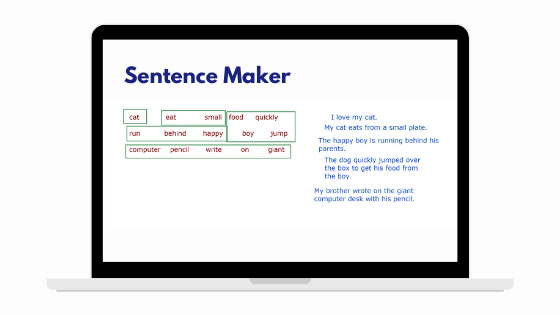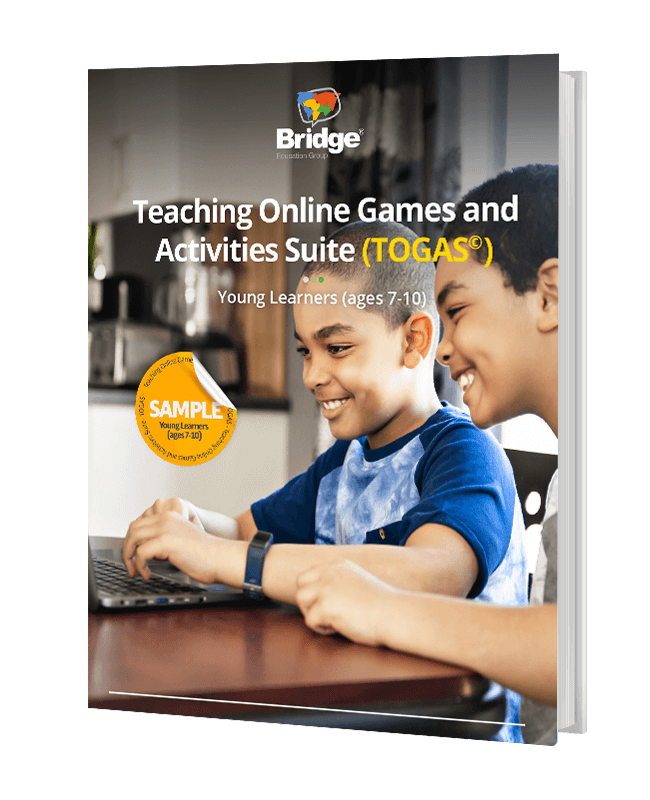Who doesn’t love playing games? Whether you use them to practice ESL vocabulary or simply break the ice with your students, games always make English classes more fun and engaging. Check out the following 12 great ESL games for online learning that you can play with your young students and teenagers – or even adults – that require minimal to no teacher preparation. (And for even more game ideas, enroll in one of our Bridge Micro-credentials in Teaching English Online, such as Games and Activities for the Online Classroom: Young Learners.)
If you’re new to teaching, you’ll want to get initial training and qualification with a TEFL certificate. You can explore our online TEFL courses to get started!
ESL online games for teaching young learners
Here are some online ESL games for English learners that are engaging and encourage student participation. These games are for English students of all ages and are shown with at least one variation. That being said, teachers should feel free to tailor them to meet their classroom’s specific goals!
Find Something…
This ESL game for teaching kids and teens online is great for improving students’ listening and thinking skills and for reviewing vocabulary.
How to play
Ask the online student to look around their room and find something of a certain color. For example, you can ask the student to find something that is pink. Give the student a minute or two to look around the room for an object that’s pink, such as a hair bow or a marker.
Alternatively, you can ask the student to look for something that begins with a specific letter. For instance, they can find an object that begins with the letter P, like a pillow or a pen.
Variation
You can ask the student to find something in your online classroom. This object, of course, will have to be visible on your screen so your student can see it without you having to move the camera around. It can be an object, a word, or a picture in your background.
Hidden Objects
This online ESL game is an effective and fun way to teach ESL vocabulary as well as listening or reading comprehension. You can use this free online ESL game for reviewing nouns, adjectives, and even prepositions of place.

How to play
Before the class, find or prepare a photo with many different objects (e.g., a messy room or a crowded beach). Share this image with the student, along with a list of ten objects which they have to find.
You can also describe the items in more detail (e.g., “Look for the big, red balloon.”).
When the student finds an object, you can either enable remote mouse control so they can circle the object or ask the student to describe the location of the item. For example, the student could say, “The cat is between the bed and the nightstand.”
Variation
You can do a person hunt and ask students to look for specific people instead. For example, “Look for the tall man in a white T-shirt” or “Where is the boy riding a blue bicycle?”
Get more ideas for teaching vocabulary with ESL Vocabulary Games for Teaching In-Person and Online.
Ready to master the terms, technology, and teaching tools used in the virtual EFL classroom?
Specialized Certification in Teaching English Online
Get CertifiedObjects Pictionary
This is a great online ESL game to practice vocabulary words using creativity and imagery. It’s a surefire way to get the whole class engaged in the lesson.
How to play
Choose an object in the room that is not visible to the student. Then, draw this on the virtual whiteboard. As you draw, the student must guess what it is, just like in the popular game Pictionary.
To make the game more challenging, you can set a timer for one minute. The teacher and student can also switch roles so the student draws the pictures and the teacher guesses the objects.
Variation
Another way to play this game is to act out the target word instead of drawing it. This variation offers a fun way to integrate TPR (Total Physical Response) into your lesson.
Like storytelling? Learn about TPRS, a language acquisition strategy that’s growing in popularity.
Missing Object
This game, featured in the Bridge Micro-credential course in Games and Activities for the Online Classroom (Very Young Learners), is great for teaching and reviewing vocabulary with students and only requires using realia from around your home or office. You can see a demonstration of how to play in the following video:
How to play
Gather a handful of objects (around five or six is good) and set them up on a tray so your students can see them all. Go over what’s on the tray by asking students what each object is called. You can also discuss the objects in greater detail (describe their appearance, ask about their function, etc.) to extend the activity.
With the tray out of view of the camera, remove one object. Show students the tray and see if they can figure out which object is missing. Once they guess correctly, put the object back on the tray, and secretly remove a different one. Play as many rounds as you want!
Variation
Instead of a tray with realia, you can also use pictures of objects that you tape up to a whiteboard. Alternatively, you could even use virtual props/images with software like ManyCam for teaching English online.
Odd One Out
This catchy ESL game helps your young students recall vocabulary and practice their listening skills and also keeps them concentrated!
How to play
Call out a list of five objects, with all but one having something in common. For example, call out banana, apple, orange, peach, and carrot. Ask the student to identify which one doesn’t belong in the group. Depending on the student’s level, you can also ask them to explain why the object is different from the rest on the list. For example, in the list above, carrot is the odd one out because it’s a vegetable and the rest are fruits.
Variation
For more advanced students, you can use similar-sounding words or various parts of speech (i.e., boot, food, room, moon, hot, etc.). You can also use pictures instead of reading the list out loud.
Leftover time at the end of class? Use one of these 10 no-prep activities for kids.
Tell Me 5
This game is good for practicing speaking skills and vocabulary. The best part is that it doesn’t require much in the way of props or setup.

How to play
List categories on the board such as colors, food, transportation, zoo animals, etc. Then, ask the student to choose a category. If the student chooses the food category, the teacher can say, “Tell me five vegetables” or “Tell me five desserts.” The student must think of five items in less than one minute.
Variation
You can also write five letters that the items in the category should start with. For example, “Tell me five vegetables that start with T, L, C, E, and K.”
Try out these 11 fun TEFL speaking activities.
Word Chain
This simple but fun online game for teaching English is excellent for building vocabulary and checking pronunciation skills.

How to play
Provide a category. Then, the first student has to say any word in that category. The next player needs to say another word in the same category, but the word must begin with the last letter of the previous word. Let’s say, for the food category, if Student A says “tomato,” Student B could say “orange.”
If a student takes too long to think of a word, they must forfeit and take a challenge. For instance, they must sing a song or talk about a topic for two minutes.
Variation
For higher-level students, you can do sentence chains by using the last word of a previous sentence as the first word of the next sentence.
Check out these other ESL pronunciation games for kids, teens, and adults.
ESL games for teaching online to teenagers (or adults)
Many English teachers will tell you that sometimes getting teens or adults to engage in play-based learning can be challenging. These games allow for the teacher to break up the routine feel of lessons and allow the students to engage with one another for a common goal. Here are some ESL games for teaching online that can be used for your older students. Fun, after all, has no age limit!
The Bragging Game
This activity not only helps your students expand their vocabulary and practice using comparative and superlative adjective forms but also helps them to be more creative.
How to play
Start by saying a simple sentence. For example, you could say, “I live in a house.” Then, the student has to “brag” by saying something greater or more exaggerated than your sentence but still within the same topic, such as, “Really? I live in a bigger house, with a pool.”
Continue this bragging game by going back and forth trying to top each other’s claim (for example, you could then counter with, “Well I live in a mansion with a pool and a jacuzzi!”). The circle ends when a person cannot think of anything to top the last example.
Variation
Instead of using the regular comparative forms, you can make it more challenging by using the “as/adjective/as/noun” form. For example, if someone says, “My best friend is as clever as a fox,” the next person could brag, “Really? Well, my best friend is as intelligent as Albert Einstein.”
Use this 5-point checklist when planning online ESL games for teens.
Classmate Speculation
An interactive activity for reinforcing grammar, speaking, and listening skills, this guessing game challenges how much you and your students know about each other!
How to play
Provide a verb that students can easily make sentences with. Then, think of information about your student using the given verb and start the sentence with the phrase “I think that you…”
Let’s say the verb is “like.” You could say, “I think that you like chocolate.”
The student shares if the information you said about him or her is true or not. If it’s true, you get a point. The first person to get five points wins.
Variation
You can also prepare sentence starters for a variety of topics and target grammar or vocabulary. For example, if you wanted to practice the past tense with your student, the sentence starters could be “I think that you traveled…” or “I think that you ate…”
These 13 easy ESL icebreakers will get your students talking.
Infuse fun into your lessons with this free eBook sample
Teaching Online Games and Activities – Young Learners
downloadSentence Maker
This game is best for reviewing vocabulary or grammar concepts that you’ve taught in previous classes.

How to play
Write a list composed of 15 words with mixed parts of speech (i.e., nouns, verbs, adjectives, adverbs, and prepositions). Then, ask the student to choose any word from the list and make a correct and logical sentence with it. You can encourage students to be creative and have fun with their sentences to keep the game interesting. Provide a point if the sentence contains the word and is grammatically correct.
Circle or cross out the first word that the student previously chose so it can’t be used anymore. Afterward, choose two new words from the list and let him or her make a new sentence using them. Give the student two points for a grammatically correct sentence containing these two new words, then circle or cross them out from the word list.
Then, the student must choose three new words from the list and create another sentence. Follow the criteria for the previous rounds.
The game ends when the last remaining five words are used in a sentence.
Variation
Alternatively, you can also show a picture and ask the learner to describe something in it using only three words. Then, raise the word count.
Need game ideas just for adults? Learn more about Bridge’s 10-hour Micro-credential Games and Activities for the Online Classroom (Adults).
Tic-Tac-Toe 2.0
This classic game adds a twist to your regular vocabulary and grammar practice exercises.

How to play
On the virtual whiteboard, write nine verbs arranged in a 3×3 grid. Then, ask the student to choose a symbol (X or O) and put their mark on any verb on the grid. Then, the student must make a correct sentence using the word he or she chooses.
The next player has to choose a box to mark and similarly make a sentence. If you’re playing the game one-on-one with your student, you can use the verb to make questions for him/her.
The first player to mark three boxes in a vertical, horizontal, or diagonal row wins.
Variation
You can personalize this game in many different ways! You can use question words, for instance, or challenge your students to various speaking tasks.
ESL Jeopardy
These ESL games for teaching online, inspired by the popular TV game show of the same name, can be wildly effective for reading comprehension, vocabulary, and even math skills.

Incorporate pop culture into your ESL classroom with these eight activities.
How to play
Before class, get the game set up on your whiteboard.
- Decide on about four to six categories for which you’ll come up with questions for the student.
- Make sure some of the categories are suitable for grammar/vocabulary questions, such as “verbs” or a flexible category like “name three.”
- Make other categories of fun topics you know will interest your student, such as “movie characters.”
- Write these categories vertically along the left side of the virtual whiteboard.
- Make columns for increasing point categories along the top of the whiteboard (i.e., 10, 20, 30, 40, 50 points).
- If you have five-point categories (from 10 to 50), you’ll now need to come up with five questions under each of your chosen categories.
- As you write your questions, remember that the higher the number of points, the more difficult the question becomes.
You can also use Google Slides to create your gameboard. Here’s how:
When you’re ready to play, explain the categories and points to the student. Then, ask the student to choose a category and a number of points. (You can have the student use the language from the TV show: “I’ll take ‘name three’ for 50 points.”) Ask the student the corresponding question. They earn the points if the answer is correct.
If you’re playing with more than one student, another player can “steal” the question if the first student doesn’t answer it correctly by attempting to answer the same question.
Variation
Instead of questions, you can use photos to reinforce vocabulary, especially for beginner students.








